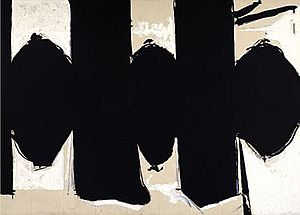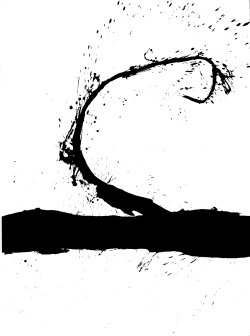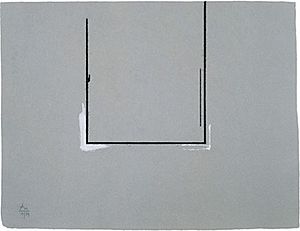Robert Motherwell facts for kids
Quick facts for kids
Robert Motherwell
|
|
|---|---|
| Born | January 24, 1915 Aberdeen, Washington, U.S.
|
| Died | July 16, 1991 (aged 76) |
| Nationality | American |
| Education | Stanford University, Harvard, Columbia University |
| Known for | Painting, Printmaking |
| Movement | Abstract expressionism |
Robert Motherwell (born January 24, 1915 – died July 16, 1991) was a famous American painter and printmaker. He was a key artist in a style called Abstract expressionism. This art style uses shapes, colors, and lines instead of clear pictures of things.
Motherwell was one of the youngest artists in the "New York School". This was a group of important abstract expressionist painters. Other artists in this group included Willem de Kooning, Jackson Pollock, and Mark Rothko. Motherwell was also known for his series of paintings and prints. These often explored ideas about history, feelings, and books. A famous series is called Elegies to the Spanish Republic.
Contents
Early Life and Learning
Robert Motherwell was born in Aberdeen, Washington, on January 24, 1915. He was the first child of Robert Burns Motherwell II and Margaret Hogan Motherwell. His family later moved to San Francisco. His father worked as the president of Wells Fargo Bank. But they went back to Cohasset Beach, Washington, every summer.
Robert had asthma, a breathing condition. Because of this, he spent most of his childhood on the Pacific Coast. He went to school mainly in California. There, he grew to love the wide-open spaces and bright colors. These later appeared in his abstract paintings. For example, he used the deep blue of the sky and the yellow of Californian hills. His thoughts about life and death also came from his health as a child.
From 1932 to 1937, Motherwell studied painting for a short time. This was at the California School of Fine Arts in San Francisco. He also earned a degree in philosophy from Stanford University. At Stanford, he learned about modernism. He read many books by writers like Stéphane Mallarmé, James Joyce, and Edgar Allan Poe. This love for literature stayed with him and became a big part of his art.
When he was 20, Motherwell traveled around Europe. He went with his father and sister. They visited Paris, Italy, Switzerland, Germany, and London. They ended their trip in Motherwell, Scotland.
Robert Motherwell wanted to be a painter. His father wanted him to choose a more stable job. They made a deal: if Robert got a Ph.D. (a high degree) so he could teach, his father would give him money each week. This would ensure he could always paint. So, Motherwell went to Harvard. He studied philosophy there.
At Harvard, Motherwell learned from important thinkers. He later spent a year in Paris. There, he studied the writings of a French painter named Eugène Delacroix. In Paris, he met American composer Arthur Berger. Berger told him to continue his studies at Columbia University. He learned from Meyer Schapiro there. In 1939, Lance Wood Hart, an art teacher, invited Motherwell to help teach his classes.
The New York School and Surrealism
In 1940, Motherwell moved to New York. He studied at Columbia University. His teacher, Meyer Schapiro, told him to focus on painting. Schapiro introduced Motherwell to a group of artists from Paris. These artists were called Surrealists. They included Max Ernst and André Masson. Motherwell also studied with Kurt Seligmann.
Spending time with the Surrealists greatly influenced Motherwell's art. In 1941, he traveled to Mexico with artist Roberto Matta. On this trip, he decided to make painting his main job. The sketches he made in Mexico became his first important paintings. These included The Little Spanish Prison (1941) and Pancho Villa, Dead and Alive (1943).
Matta taught Motherwell about "automatic drawing." This is a technique where artists draw without thinking too much. The Surrealists used it to explore their unconscious minds. This idea had a lasting impact on Motherwell. He also met artist Wolfgang Paalen in Mexico. Motherwell stayed in Mexico longer to work with Paalen. His Mexican Sketchbook shows how his art changed during this time.
When Motherwell returned from Mexico, he worked on his creative ideas. He realized American artists could paint wonderfully. But they needed a new way to create art. He thought "free association" (like in automatic drawing) could lead to something new.
So, in the early 1940s, Robert Motherwell helped start Abstract expressionism. This new art movement was also called the New York School. Matta wanted to begin a new art movement. He asked Motherwell to find other American artists. Motherwell talked to artists like Jackson Pollock and Willem de Kooning. Peggy Guggenheim, who liked their art, offered to show their new work. Motherwell explained the idea of automatism to everyone. This helped create a common idea for the new movement.
In 1942, Motherwell began showing his art in New York. In 1944, he had his first solo show at Peggy Guggenheim's gallery. That same year, the MoMA (Museum of Modern Art) bought one of his works. By the mid-1940s, Motherwell became a leading voice for new art in America. He worked with artists like William Baziotes and Mark Rothko. They even started an art school together. In 1949, Motherwell divorced his first wife. In 1950, he married Betty Little and had two daughters.
Motherwell was also involved in art magazines. He was on the board of VVV and wrote for DYN. He also edited a book called The Dada Painters and Poets: An Anthology in 1951.
In 1948, Motherwell created an image that led to his famous series, Elegies to the Spanish Republic. He worked with art critic Harold Rosenberg on an art review. Motherwell made an image for the review that combined a poem with abstract shapes. The image had black oval and rectangular shapes on a white background. This stark image was meant to show the strong feelings of the poem.
The art review's second issue was never published. Motherwell put the image away. About a year later, he found it again and decided to work with its basic shapes. This led to the Elegies to the Spanish Republic series. He continued to create these paintings for the rest of his life. He later named the original image Elegy to the Spanish Republic No. 1. A good example is Elegy to the Spanish Republic No. 110 (1971). It uses the same shapes. These abstract images are seen as showing strong feelings about Hispanic culture.
In 1948, Motherwell and other artists started the Subjects of the Artist School. They held public talks with famous speakers like John Cage. The school closed in 1949 because of money problems. During the 1950s, Motherwell taught painting at Hunter College and Black Mountain College. Artists like Cy Twombly and Robert Rauschenberg studied with him. He also wrote and gave many talks.
From 1954 to 1958, Motherwell worked on a small series of paintings. These paintings included the words "Je t'aime" (French for "I love you"). They showed his personal feelings. He also started using things from his studio in his collages. These included cigarette packets and labels. They became like a record of his daily life. He married for the third time in 1958 to fellow abstract painter Helen Frankenthaler. They were known as "the golden couple" because they were both wealthy and hosted many parties.
Later Years
In 1958–59, Motherwell's art was part of a big exhibition. It was called "The New American Painting" and traveled across Europe. In 1958, he and Frankenthaler spent three months in Spain and France. He felt a new burst of energy for painting, which he said came from her influence. His Two Figures series from that year shows how her bright colors affected his work.
During the 1960s, Motherwell's art was shown widely in America and Europe. In 1965, he had a major show at the Museum of Modern Art. This show then traveled to other cities. In 1962, Motherwell and Frankenthaler spent the summer in Provincetown, Massachusetts. The coastline there inspired his Beside the Sea series of 64 paintings. He used oil paint to create splashes, like the sea crashing on the shore. The 1963 painting Untitled in the Honolulu Museum of Art shows this period in his art.
In 1964, Motherwell created a large painting called Dublin 1916, with Black and Tan. It is in the Governor Nelson A. Rockefeller Empire State Plaza Art Collection in Albany, NY. Its size and meaning suggest Motherwell wanted to create a monument to bravery, like Picasso's famous painting Guernica.
In 1965, Motherwell worked on another important series called the Lyric Suite. He bought a thousand sheets of Japanese paper. He decided to paint on all of them without making any corrections. He completed 600 paintings in two months. Then, his friend, sculptor David Smith, died in an accident. Motherwell stopped working on the series. He later said he liked them very much and that they "half painted themselves."
In 1967, Motherwell started his Open series. He was inspired by seeing a large and small canvas next to each other. The Open paintings kept Motherwell busy for almost 20 years. They use simple color areas with a few lines that form loose rectangular shapes. As the series went on, the paintings became more complex.
In the late 1960s, Motherwell often used Gauloises cigarette packets in his collages. He made a large series with the packets surrounded by bright red paint.
In 1972, Motherwell married artist-photographer Renate Ponsold. They moved to Greenwich, Connecticut. During the 1970s, his art was shown in many European cities. In 1977, he was asked to create a large mural for the National Gallery of Art in Washington, D.C.
In 1983, a big show of Motherwell's work was held in Buffalo, New York. This show then traveled to other major museums across the United States. Another show was held in Mexico City and Texas in 1991. In 1985, Motherwell received the Edward Macdowell Medal for his achievements.
In 1988, Motherwell worked with a publisher to create a special edition of the book Ulysses by James Joyce. Motherwell created 40 lithographs (a type of print) for the book.
Death and Legacy
Robert Motherwell died in Provincetown, Massachusetts, on July 16, 1991. After his death, art critic Clement Greenberg said Motherwell was "one of the very best of the abstract expressionist painters."
The Dedalus Foundation was started by Robert Motherwell in 1981. Its goal is to help people understand modern art. It supports research, education, and exhibitions. When Motherwell died, he left a large collection of his art.
On July 20, 1991, many people attended a memorial service for Motherwell. It was held on the beach outside his home in Provincetown. The poet Stanley Kunitz read a poem that Motherwell loved. Family, friends, and other artists were there.
Selected Exhibitions
Many major exhibitions of Motherwell's work have been held. Here are some of them:
- Peggy Guggenheim's Art of this Century Gallery, New York (1944)
- Bennington College, Bennington, Vermont (1957)
- Galerie Heinz Berggruen, Paris, France (1961)
- Pasadena Art Museum, California (1962)
- Smith College Museum of Art (1963)
- The Phillips Collection, Washington, D.C. (1965)
- The Museum of Modern Art, New York (1965)
- The Museum of Fine Arts, Houston, Texas (1972–73, traveled)
- David Mirvish Gallery, Toronto, Ontario, Canada (1973)
- Princeton University Art Museum, New Jersey (1973)
- Museo de Arte Moderna, Mexico City, Mexico (1975)
- Stadtisches Kunsthalle, Düsseldorf, Germany (1976)
- Musée d'art moderne de la ville de Paris, France (1977)
- Royal Academy of Art, London, England (1978)
- The William Benton Museum of Art, University of Connecticut, Storrs (1979)
- Fundación Juan March, Madrid, Spain (1980)
- Albright-Knox Art Gallery, Buffalo, New York (1983, traveled)
- Walker Art Center, Minneapolis, Minnesota (1985)
- Museo Rufino Tamayo, Mexico City, Mexico (1991–92, traveled)
- Fundació Antoni Tàpies, Barcelona, Spain (1996–97, traveled)
- Museum Morsbroich, Leverkusen, Germany (2004–05)
- Art Gallery of Ontario, Canada (2011)
Books by and about Robert Motherwell
- Robert Motherwell, The Dada Painters and Poets, R. Motherwell, New York, 1951.
- Robert Motherwell, The Collected Writings of Robert Motherwell, University of California Press, 1999.
- Robert Motherwell translated to English Paul Signac's book, D'Eugène Delacroix au néo-impressionisme, 1938.
- Arnason, H.H. Robert Motherwell. New York: Harry N. Abrams, 1977; revised edition 1982.
- Motherwell, Robert, Engberg, Siri and Joan Banach. Robert Motherwell: The Complete Prints 1940–1991. Minneapolis: Walker Art Center, 2003.
- Flam, Jack. Motherwell. London: Phaidon, 1991
- Marika Herskovic, American Abstract Expressionism of the 1950s An Illustrated Survey, (New York School Press, 2003.) ISBN: 0-9677994-1-4. p. 238-241
- Marika Herskovic, New York School Abstract Expressionists Artists Choice by Artists, (New York School Press, 2000.) ISBN: 0-9677994-0-6. p. 11; p. 16; p. 27; p. 38; p. 258-261
- Robert Hobbs. "Robert Motherwell Retrospective." Düsseldorf: Städische Kunsthalle Düsseldorf, 1976.
- Robert Hobbs, Matthew Collings, Mel Gooding and Robert Motherwell. "Open." London: 21 Publishing Ltd., 2009 .
- Kingsley, April. The Turning Point: The Abstract Expressionists and the Transformation of American Art. New York: Simon & Schuster, 1992.
- Pleynet, Marcelin. Robert Motherwell. Paris: Daniel Papierski, 1989.
Images for kids
-
Robert Motherwell, Ulysses, 1947, oil paint on cardboard and wood construction, Tate Modern
See also
 In Spanish: Robert Motherwell para niños
In Spanish: Robert Motherwell para niños





